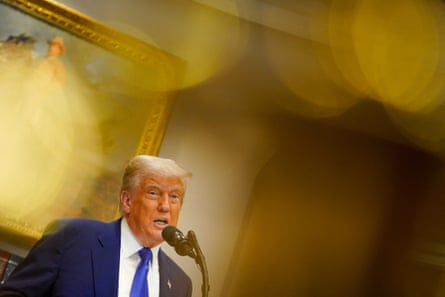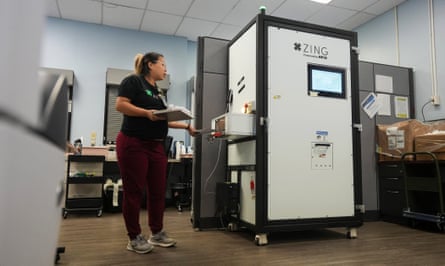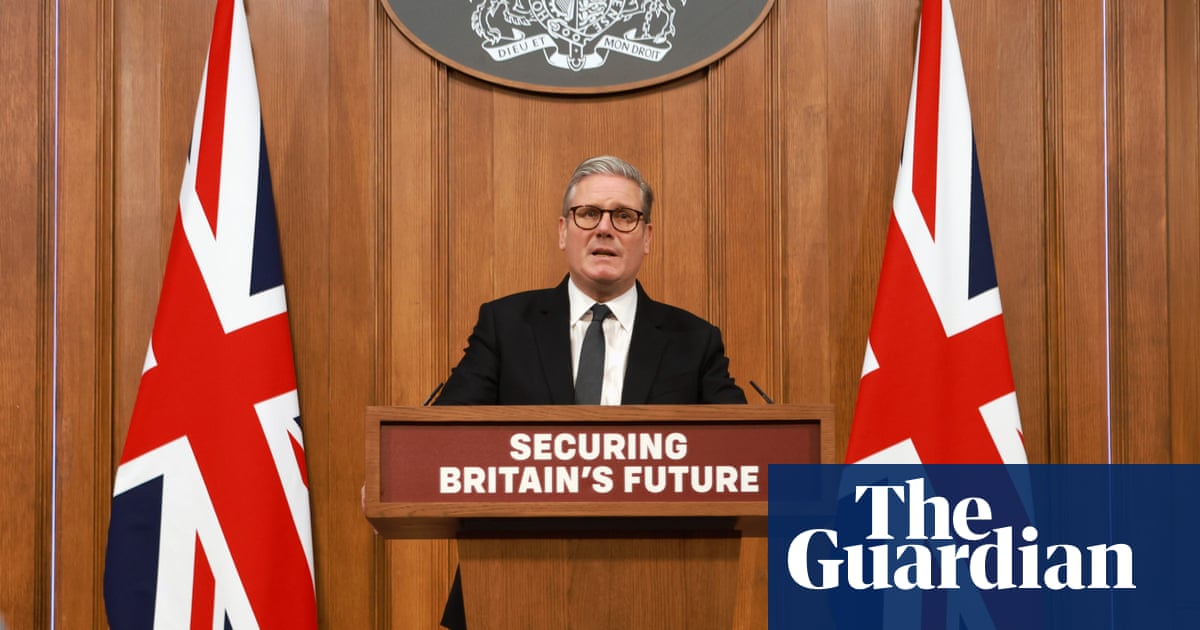Hello, and welcome to TechScape. Sometimes it helps me to write by thinking about how a radio broadcaster or television presenter would deliver the information, so I’m your host, Blake Montgomery. Today in tech news: questions hover over the automation of labor in the worker-strapped US healthcare system; and drones proliferate in a new conflict: India v Pakistan, both armed with nuclear weapons. But first, how fights over AI and copyright take very different shapes in the UK and US.
‘A brazen, unprecedented power grab’
The United Kingdom is in the throes of a debate over whether to compensate artists’ for the use of their copyrighted work in the creation of generative artificial intelligence technology. The fracas came to head on Monday with a vote in the House of Lords that saw parliament’s upper house demand tech companies make clear whether they have used copyright-protected content.
My colleagues Dan Milmo and Raphael Boyd report:
The UK government has suffered another setback in the House of Lords over its plans to let artificial intelligence firms use copyright-protected work without permission.
An amendment to the data bill requiring AI companies to reveal which copyrighted material is used in their models was backed by peers, despite government opposition.
The government’s copyright proposals are the subject of a consultation due to report back this year, but opponents of the plans have used the data bill as a vehicle for registering their disapproval.
The main government proposal is to let AI firms use copyright-protected work to build their models without permission, unless the copyright holders signal they do not want their work to be used in that process – a solution that critics say is impractical and unworkable.
Read the full story about Monday’s vote here.
Meanwhile, in contrast to a thoughtful and robust conversation, the US is taking the opposite tack. Over the weekend, Donald Trump fired the head of the US copyright office, CBS News reported. Register of Copyrights, Shira Perlmutter, was sacked after she issued a report questioning AI companies’ growing need for more data and casting doubt on their expressed need to circumvent current copyright laws.
In a statement, New York Democratic representative Joe Morelle pointed specifically to Trump’s booster-in-chief Elon Musk as a motivator for Perlmutter’s firing: “Donald Trump’s termination of register of copyrights, Shira Perlmutter, is a brazen, unprecedented power grab with no legal basis. It is surely no coincidence he acted less than a day after she refused to rubber-stamp Elon Musk’s efforts to mine troves of copyrighted works to train AI models.”
Trump’s abrupt severing of the copyright chief from her job reminds me of the Gordian knot. Legend has it that Alexander the Great was presented with a knot in a rope tying a cart to a stake. So complex were its twistings that no man had been able to untie it of the hundreds who had tried. Alexander silently drew his sword and sliced the knot in two. The story is one of a great man demonstrating the ingenuity that would lead him to conquer the world. Alexander did solve the riddle. He also defeated its purpose. The cart is left with no anchor. Perhaps the riddle had taken on more significance than the original problem of keeping the cart in place, but that is a question for another day.
Trump may have cut through any thorny legal questions the copyright office had raised, but the vacuum at the head of the US’s copyright authority means that richer and better-connected players will run roughshod over copyright law in the course of their business. That may be what the president wants. The more powerful players in lawsuits over AI and copyright are undoubtedly the well capitalized AI companies, as much as I want artists to be paid in abundance for their creativity. These tech companies have cozied up to Trump in an effort to ensure a friendlier regulatory environment, which seems to be working if the firing of the copyright chief is any evidence. Lawsuits over how much AI companies owe artists and publishers for their surreptitious use of copyrighted material with an avowed lack of permission still abound, and both plaintiffs and defendants will be taking their cues from the US copyright office.
Trump sells access on the blockchain

My colleague Nick Robins-Early reports on a sweepstakes put on by Trump promising face-time with the president to holders of his cryptocurrency:
On Monday, the top 220 buyers of a Donald Trump-sponsored cryptocurrency won access to an exclusive dinner with the president as a reward for pouring money into the coin. It was the culmination of Trump’s weekslong promotion of the contest, which has drawn allegations that he is using his position to enrich his family business while opening himself up to foreign influence.
The cryptocurrency, called $TRUMP, was created in mid-January and boasts a market capitalization of over $2bn after months of investors buying into the heavily promoted coin. A Trump family-linked company and another firm own a majority of the coins, according to Reuters.
“Congratulations, if you’re in the top 220 on the leaderboard we will be contacting you in the next 24 hours. Check your inbox (and spam folder) and expect a phone call for the Trump Official Dinner invitation and details,” the $TRUMP website announced mid-day Monday. “President Trump will see YOU on May 22 at the Gala Dinner in Washington D.C.”
Trump’s crypto enterprise has drawn criticism from Democrats, ethics watchdogs and the Securities and Exchange Commission over conflicts of interest and allegations of corruption. The contest to dine with the president has intensified those concerns as it creates what is essentially a bidding war for direct access to the president.
Drones proliferate along the border between India and Pakistan

Though India and Pakistan have reached a tenuous ceasefire, the four days of open conflict between the two hostile neighbors offered yet another instance of a phenomenon that has accelerated in recent years: drones now play a central part in modern warfare.
after newsletter promotion
The New York Times reports that India accused Pakistan of using drones made by Turkey for its attacks; Pakistan alleged India mobilized Israeli drones, though neither could be verified. Indian military officials claimed that Pakistan had sent between 300 to 400 drones on the offensive at 36 locations on the night of 8 May. Pakistan said it had shot down some 70 drones flown from India.
“Drones” refers to two things that are related but very different: small quadcopters operated by remote control and much larger semi-autonomous aerial vehicles operated from military command centers. It is an unfortunate quirk of English, in my opinion. In India and Pakistan, as well as in Ukraine and Myanmar, the smaller unmanned aircraft have become a mainstay weapon.
The war between Ukraine and Russia has demonstrated how widely drones have proliferated. Explosive quadcopters, equipped with first-person view and functioning as aerial improvised explosive devices, have carried out some of the most dramatic attacks of the conflict, including a bombing of the Kremlin itself in May 2023. One expert summarized the development to the Guardian earlier this year by describing drones as evolving from “a novelty in 2022, to one of the weapons of choice in 2023, to roaming the entire tactical space”.
Can the US automate its way out of a shortage of healthcare workers?

One of the great fears of our age is that machines will replace our jobs en masse, leaving the human workforce in the lurch. The Guardian published a story over the weekend about Zing, a robot that dispenses methadone, a drug used in treatment for the opioid addiction that has spread through the veins of the US in recent decades. Beneath the story of innovation runs an undercurrent: where do we draw the line between automation that offers genuine help to workers and profiteering preference for robot labor over humans?
Read the full story about drug-dealing robots here.
The story published one day before Walgreens announced it would expand the services of its “micro-fulfillment centers” – hubs where prescription-dispensing robots count and package medications for chronic health conditions for the company’s pharmacies, CNBC reports. Already, these automated centers handle about 16m prescriptions each month, 40% of prescriptions served by Walgreens, according to the company. The company plans to up the number of stores that rely on these centers from 4,800 in February to 5,000 by the end of the year. Walgreens says the shift to automated labor, begun in 2021, is already producing financial results, some $500m in cost savings over the past four years.
Pharmacy techs suffer from similar issues as methadone-dispensing nurses – low pay, intense pressure, and high turnover rates – but at a much wider scale. Walgreens is a massive conglomerate of some 12,500 stores across the US, Europe and Latin America worth about $9.7bn; it employs 312,000 people, per its website.
In 2023, Walgreens’ pharmacy workers staged walkouts across the US to protest their working conditions. Chief among their concerns: chronic understaffing and burnout among the workers who chose to stay. They called the protests “Pharmageddon”.
Walgreens may hire fewer pharmacy workers because it has automated their labor and outsourced it to a micro-fulfilment center. But it seems equally possible based on what pharmacy workers say that those jobs were going unfilled to begin with, leading to unsafe working conditions. Automated labor may fill the gap left by the labor shortage. The same dynamic may play out at methadone clinics across the United States.
Already, Walgreens corporate says its automated labor is helping alleviate the problems workers face and allowing staff to spend more time interacting with patients in person. Among the stats: a 40% increase in vaccine dispensations, which are performed person-to-person, at pharmacies served by its automated prescription system.
Read more about the automation of labor in a different arena: Amazon warehouses here.

 2 hours ago
8
2 hours ago
8













































